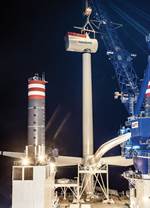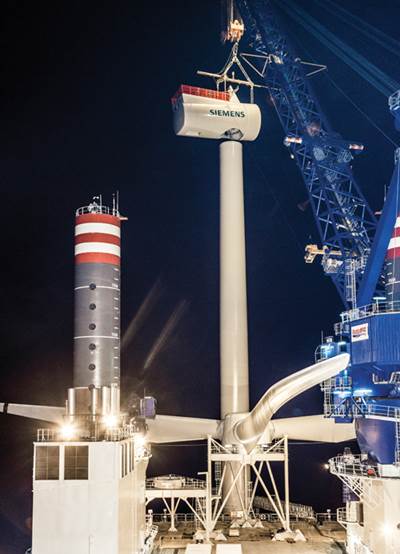Redefining the root
As part of a radical redesign effort that has produced a segmented blade, Blade Dynamics Ltd. (Cowes, Isle of Wight, U.K.) developed a thinner, less weighty root than that seen in conventional blades.
As wind turbine blades lengthen, the strength-to-weight ratio becomes a mathematically more difficult equation because blade mass increases at a faster rate than energy capture. The critical role played by the blade root, the blade’s point of connection to the rotor and a focal point of operational stress, makes it a particularly challenging target for weight reduction. Nevertheless, blade designers are increasingly taking aim, and the results are promising.
LM Wind Power (Kolding, Denmark), for example, says its all-glass fiber-reinforced 73.5m/240-ft long blade, currently the world’s longest installed blade, features a GloBlade root with the same bolt circle diameter used on smaller LM blades. At 3.2m/10.4 ft, the root’s optimized design supports the blade’s greater mass.
Although details of LM’s optimized root aren’t available, much more is known about the unconventional root design for the longest wind turbine blade produced to date. its builder, SSP Technology A/S (Kirkeby, Denmark), used a root design for the 83.5m/271-ft structure that is now available for sale to other blade producers as a kit or a standalone part.
It is made with glass/epoxy prepregs that are precut on computerized cutting machines. Although a conventional root features a very thick fiberglass laminate that must be drilled, postcure, for insertion of T-bolts, SSP’s relatively thin root section is formed in two female mold halves. Steel inserts or bushings, approximately 460 mm/18 inches long and located about 25 mm/1 inch apart, are encapsulated within the oven-cured prepreg layup.
Says SSP’s CEO, Søren Brouer, “The prepreg construction holds the bolt inserts so tightly that we have not been able to pull any out during testing.” SSP says the minimal distance between the comolded bolts optimizes its load-bearing capacity. Further, Brouer points out that when an SSP blade is attached to a rotor hub during wind farm installation, there is no need for follow-up retightening of the bolts during the first maintenance round. This eliminates a costly and laborious step that is required for traditional, bonded T-bolts.
As part of a radical redesign effort that has produced a segmented blade, Blade Dynamics Ltd. (Cowes, Isle of Wight, U.K.) developed a thinner, less weighty root than that seen in conventional blades. The solution is a composite “carrot”-shaped root insert that tapers to a thin wedge. To create the inserts, composite material is wrapped around metal bushings that have spiral threading on the inside and outside. Closely spaced inserts are then embedded within a thin “corrugated” root laminate, explains Blade Dynamics’ senior technical manager, David Cripps (see image). “The whole arrangement is much lighter than conventional roots where T-bolts are used, which require very thick laminates to provide the necessary bearing area for the ‘nut’ of the T-bolt and to spread the arising stress concentrations into the blade root and spar arrangement,” Cripps explains. The company says the greater strength-to-weight and fatigue resistance of its root contributes to the overall lower weight of its blades. That, in turn, allows for the use of lighter components throughout the turbine and rotor, including drivetrain components, and reduces overall project costs.
Related Content
Polar Technology develops innovative solutions for hydrogen storage
Conformable “Hydrogen in a Box” prototype for compressed gas storage has been tested to 350 and 700 bar, liquid hydrogen storage is being evaluated.
Read MoreSRI develops scalable, infiltration-free ceramic matrix composites
Work in two DOE projects is demonstrating C/C-SiC produced in 3-5 days with <5% shrinkage, <10% porosity and 50% the cost of conventional C/C and C/C-SiC.
Read MoreCeramic matrix composites: Faster, cheaper, higher temperature
New players proliferate, increasing CMC materials and manufacturing capacity, novel processes and automation to meet demand for higher part volumes and performance.
Read MoreWe4Ce infused 2.5-3-MW rotor blade design passes validation test
Composite rotor blade structure design by We4Ce, mold and prototype production by InDutch Composites and fatigue testing by Suzlon Group has resulted in the novel blade’s IEC61400-5:2020 certification.
Read MoreRead Next
Fair winds for offshore wind farms
Innovations in blades, turbines and foundations are helping spur growth in a very big way.
Read MoreNext-gen fan blades: Hybrid twin RTM, printed sensors, laser shock disassembly
MORPHO project demonstrates blade with 20% faster RTM cure cycle, uses AI-based monitoring for improved maintenance/life cycle management and proves laser shock disassembly for recycling.
Read MoreCeramic matrix composites: Faster, cheaper, higher temperature
New players proliferate, increasing CMC materials and manufacturing capacity, novel processes and automation to meet demand for higher part volumes and performance.
Read More












